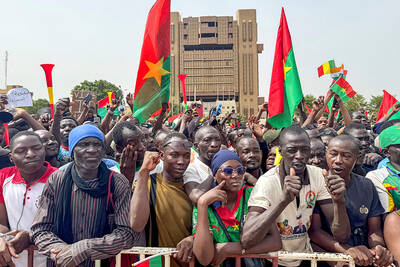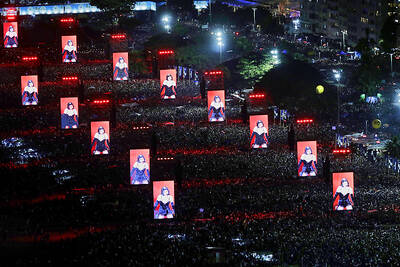Afghanistan has many dubious distinctions on the international-rankings front: 10th poorest, third most corrupt, worst place to be a child, longest at war. To that may soon be added: most heavily fingerprinted.
Since September, Afghanistan has been the only country in the world to fingerprint and photograph all travelers who pass through Kabul International Airport, arriving and departing.
A handful of other countries fingerprint arriving foreigners, but no country has ever sought to gather biometric data on everyone who comes and goes, whatever their nationality. Nor do Afghan authorities plan to stop there: Their goal is to fingerprint, photograph and scan the irises of every living Afghan.
It is a goal heartily endorsed by the US military, which has already gathered biometric data on 2 million Afghans who have been encountered by soldiers on the battlefield, or who have just applied for a job with the coalition military or its civilian contractors.
The Kabul airport program is also financed by the US, with money and training provided by the US embassy. US citizens, like all other travelers, are subject to it.
“Some of the embassies are quite exercised about it,” one Western diplomat said.
Such a program would be illegal if carried out in the home countries of most of the occupying coalition. The US and Japan fingerprint all foreigners on arrival; South Korea plans to start doing so in January. Brazil retaliated against the US program by fingerprinting arriving US citizens only. Officials at the US embassy declined to comment specifically on the program; a spokesman for the US Department of Homeland Security denied it had anything to do with it.
Biometric data is also being gathered by the US military at all of Afghanistan’s eight major border crossings, in a program that it plans to hand over to the Afghan government at the end of this month. So far, that program gathers only random samples at border crossings because traffic is so heavy, but since it began in April it has already added 200,000 people to the military’s biometrics database.
The military wants to use biometrics to identify known or suspected insurgents and to prevent infiltration of military bases and Afghan security forces.
Gathering the data does not stop at Afghanistan’s borders, however, since the military shares all of the biometrics it collects with the US Department of Justice and Homeland Security through interconnected databases.
Even the civilian-run airport program collecting fingerprints and photographs feeds its information into computers at the US embassy, as well as at the Afghan Ministry of the Interior and its intelligence agency, the National Directorate of Security, according to head of the Kabul International Airport, Mohammad Yaqub Rasuli.
Rasuli acknowledges that the airport screening has had a rocky start.
“We are happy with the system, but the airlines and the passengers are not that happy,” he said.
Delays of up to two hours have resulted from the screening, which takes at least three minutes per passenger. With six screening stations at most, the process becomes laborious and so many travelers recently have been missing their flights that the airlines routinely delay takeoffs.
Reporters at the airport have on several occasions witnessed immigration officers just waving through some passengers as crowds backed up; others were allowed to skip their thumbprints to speed things along. One man had his hand fingerprinted upside down, with nails facing the scanner.
“It is some sort of cultural deficiency,” Rasuli said. “After six months, everyone will be happy with it.”
The next step will be a national identity card with biometric data on every citizen, he said.
Information on each person is fed into a computer to find those who are on terrorist watch lists, have outstanding criminal warrants or are businessmen under investigation.
How many suspects have been apprehended with the new system, Rasuli was asked.
“None,” he said.
The military has done somewhat better with its program, according to director of the US Army’s biometrics task force, Colonel Fred Washington. Since 2007, when biometric collection began in Afghanistan, biometrics have been used to identify 3,000 suspects on either Watch List 1 or Watch List 2, the US military’s two most serious classifications for possible insurgents or terrorists. In many cases, fingerprints found on bomb remains have identified the bomb-maker, he said.
“People are accepting it because they know it’s making their country secure,” Washington said.
Executive director of the Afghan Independent Human Rights Commission, Mohammad Musa Mahmoodi, said: “Given the circumstances in Afghanistan, fighting terrorism and insurgency, government can take measures to protect its citizens.”
Civil liberties groups abroad are more concerned.
“The situation in Afghanistan is unprecedented, but I worry that we could move into that situation in the United States without even realizing we’re doing it,” said Jennifer Lynch, a staff attorney at the Electronic Frontier Foundation in San Francisco.
There have been some signs of Afghan sensitivities as well. A program to gather biometric data Kandahar last year, during the push to control insurgency there, was so unpopular that Afghan President Hamid Karzai promised local elders to have it canceled, which it was, according to Zalmai Ayoubi, a spokesman for the governor in Kandahar Province.
The Afghan government has yet to pass legislation providing for the biometric screening of the entire population that it plans to carry out for the national identity card.
As a result, the military has not conducted wholesale sweeps of communities to gather biometrics, Washington said, although in just the past year 12,000 soldiers have been trained to use the Biometric Automated Toolset (BAT).
“We can’t go door to door,” he said.
The Commander’s Guide to Biometrics in Afghanistan, however, encourages documenting as many Afghans as possible.
“Every person who lives within an operational area should be identified and fully biometrically enrolled with facial photos, iris scans and all 10 fingerprints [if present],” the guide says.
While the BAT equipment is portable, it is not always easy to use and the results can sometimes be unpredictable.
A reporter from the New York Times, a US citizen of Norwegian rather than Afghan extraction, voluntarily submitted to a test screening with the BAT system. After his fingerprints and iris scans were entered into the BAT’s armored laptop, an unexpected “hit” popped up on the screen, along with the photograph of a heavily bearded Afghan.
The “hit” identified the reporter as “Haji Daro Shar Mohammed,” who is on terrorist Watch List 4, with this note: “Deny access, do not hire, subject poses a threat.”

Kehinde Sanni spends his days smoothing out dents and repainting scratched bumpers in a modest autobody shop in Lagos. He has never left Nigeria, yet he speaks glowingly of Burkina Faso military leader Ibrahim Traore. “Nigeria needs someone like Ibrahim Traore of Burkina Faso. He is doing well for his country,” Sanni said. His admiration is shaped by a steady stream of viral videos, memes and social media posts — many misleading or outright false — portraying Traore as a fearless reformer who defied Western powers and reclaimed his country’s dignity. The Burkinabe strongman swept into power following a coup in September 2022

‘FRAGMENTING’: British politics have for a long time been dominated by the Labor Party and the Tories, but polls suggest that Reform now poses a significant challenge Hard-right upstarts Reform UK snatched a parliamentary seat from British Prime Minister Keir Starmer’s Labor Party yesterday in local elections that dealt a blow to the UK’s two establishment parties. Reform, led by anti-immigrant firebrand Nigel Farage, won the by-election in Runcorn and Helsby in northwest England by just six votes, as it picked up gains in other localities, including one mayoralty. The group’s strong showing continues momentum it built up at last year’s general election and appears to confirm a trend that the UK is entering an era of multi-party politics. “For the movement, for the party it’s a very, very big

ENTERTAINMENT: Rio officials have a history of organizing massive concerts on Copacabana Beach, with Madonna’s show drawing about 1.6 million fans last year Lady Gaga on Saturday night gave a free concert in front of 2 million fans who poured onto Copacabana Beach in Rio de Janeiro for the biggest show of her career. “Tonight, we’re making history... Thank you for making history with me,” Lady Gaga told a screaming crowd. The Mother Monster, as she is known, started the show at about 10:10pm local time with her 2011 song Bloody Mary. Cries of joy rose from the tightly packed fans who sang and danced shoulder-to-shoulder on the vast stretch of sand. Concert organizers said 2.1 million people attended the show. Lady Gaga

SUPPORT: The Australian prime minister promised to back Kyiv against Russia’s invasion, saying: ‘That’s my government’s position. It was yesterday. It still is’ Left-leaning Australian Prime Minister Anthony Albanese yesterday basked in his landslide election win, promising a “disciplined, orderly” government to confront cost-of-living pain and tariff turmoil. People clapped as the 62-year-old and his fiancee, Jodie Haydon, who visited his old inner Sydney haunt, Cafe Italia, surrounded by a crowd of jostling photographers and journalists. Albanese’s Labor Party is on course to win at least 83 seats in the 150-member parliament, partial results showed. Opposition leader Peter Dutton’s conservative Liberal-National coalition had just 38 seats, and other parties 12. Another 17 seats were still in doubt. “We will be a disciplined, orderly